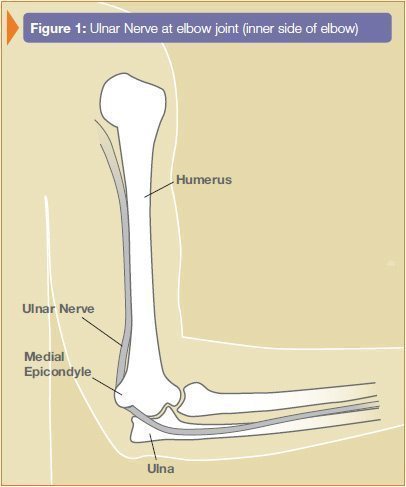The ulnar nerve runs along the ulna bone in the forearm before it enters the hand near the little and ring fingers. The ulnar nerve is one of the largest nerves in the human body, but it has almost no protection. This lack of protection makes the ulnar nerve very susceptible to damage. The most common problem with this important nerve is cubital tunnel syndrome.
Cubital tunnel syndrome is a medical condition that forms when there is too much pressure placed on the ulnar nerve. Constantly using your elbow to lean against a hard surface or bending the elbow for an extended period of time are the two most common causes of cubital tunnel syndrome. While these actions may not seem very serious, they are able to cause damage because the ulnar nerve has almost no padding to protect against direct pressure and stretching. It is also possible to develop cubital tunnel syndrome because of an anomaly in the anatomy of your elbow.
It is very easy to spot the signs and symptoms of cubital tunnel syndrome. The medical condition will cause severe pain and numbness in the elbow. You will also likely experience some tingling, weakness and loss of feeling in your ring and little fingers. These issues with the elbow and fingers can make it difficult to close your hand to hold objects. While these symptoms can occur at any time, they will become more severe if the elbow is bent for an extended period of time.
You will need to get properly diagnosed with cubital tunnel syndrome before beginning treatment. The condition can usually be diagnosed with a simple physical examination by our doctor. A nerve test and electromyography may also be done to confirm the diagnosis and look for any serious nerve damage.
Once you have been diagnosed with the condition, it will be time to start treating it. The first thing everyone with cubital tunnel syndrome should do is avoid any actions or activities that place too much pressure on the ulnar nerve and elbow. You must avoid placing your elbow on a hard surface at all times. You may also need to wear a splint at night if you are known to bend your elbow while sleeping.
If these lifestyle changes are not enough to reduce your painful symptoms, then you may need to undergo surgery. The ulnar nerve will be released and moved to the front of the elbow during a cubital tunnel surgery. You may also need to get a portion of your bone removed during the surgery. The surgery will increase the size of the cubital tunnel, which decreases the pressure placed on the ulnar nerve.
Cubital tunnel syndrome surgery is very effective at reducing your painful symptoms. It will likely take several weeks before you see an improvement in your symptoms. Physical therapy can be used to speed up the recovery process, but complete recovery from the surgery will likely take several months.
If you have cubital tunnel syndrome, our trusted doctor can help you at Arora Hand Surgery, conveniently located in Warren, Macomb, West Bloomfield, and Howell. Contact us to schedule your consultation and learn more about your treatment options.




 What many people call the “funny bone” really is a nerve. This ulnar nerve runs behind a bone in the elbow through a space called the “cubital tunnel” (Figure 1). Although “banging the funny bone” usually causes temporary symptoms, chronic pressure on or stretching of the nerve can affect the blood supply to the ulnar nerve, causing numbness or tingling in the ring and small fingers, pain in the forearm, and/or weakness in the hand. This is called “cubital tunnel syndrome.”
What many people call the “funny bone” really is a nerve. This ulnar nerve runs behind a bone in the elbow through a space called the “cubital tunnel” (Figure 1). Although “banging the funny bone” usually causes temporary symptoms, chronic pressure on or stretching of the nerve can affect the blood supply to the ulnar nerve, causing numbness or tingling in the ring and small fingers, pain in the forearm, and/or weakness in the hand. This is called “cubital tunnel syndrome.”










